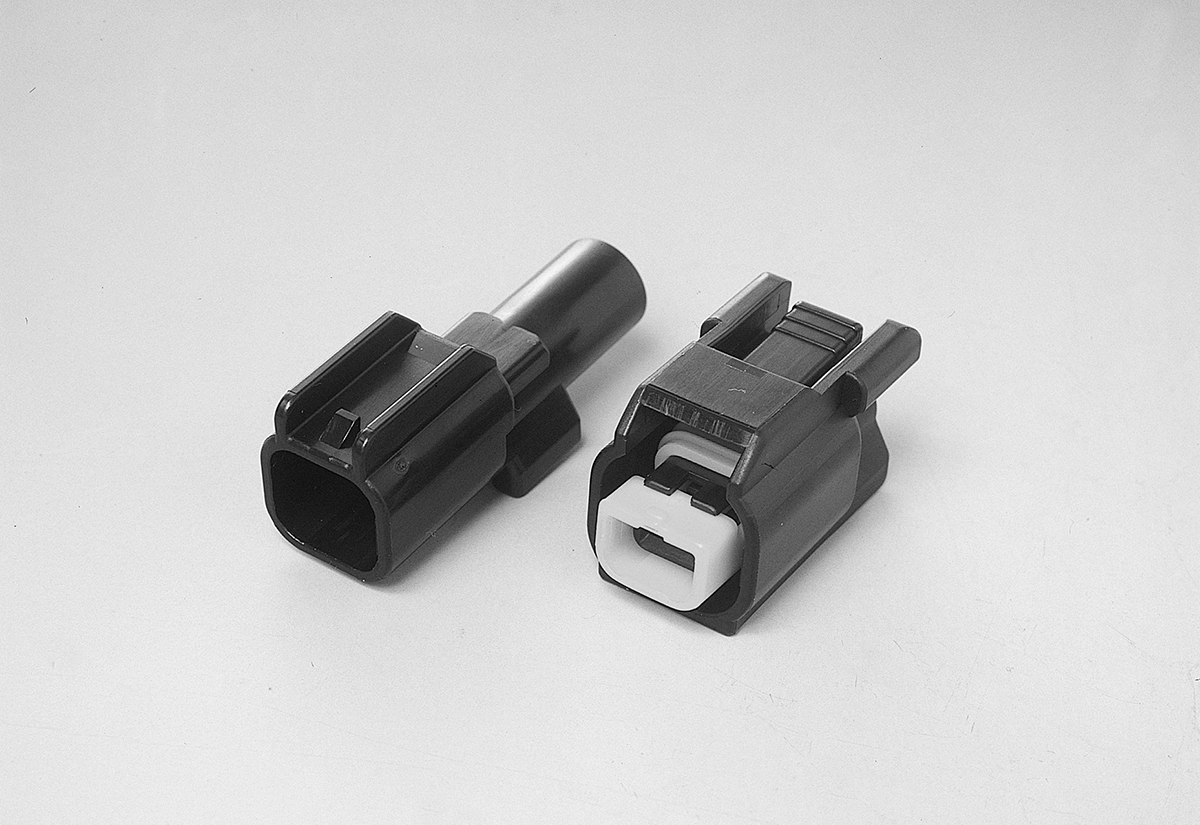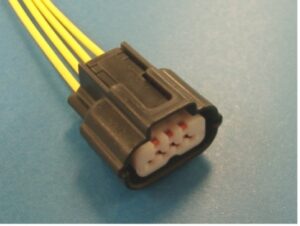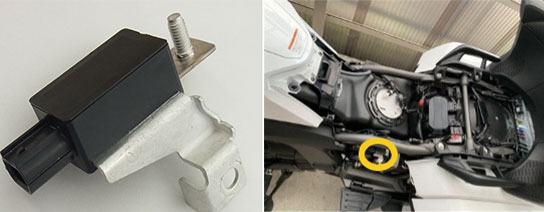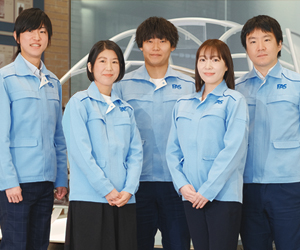Interviews: Among the motorcycle parts manufactured by FAS are wire harnesses, connectors and BSS®. In these interviews, we join the developers for a deep dive on these products.
Table of Contents
The Roots of Motorcycle Wire Harnesses in Car Development
FAS wire harnesses are adopted in countless motorcycles today. Originally, these components were developed for use in cars. FAS motorcycle wire harnesses emerged as a result of the host of engineering capabilities FAS cultivated in the process of developing car components. In this section, we take a look at how wire harnesses for motorcycles evolved.
We spoke with T and M, two developers in FAS’ Engineering Division.

The things that keep together the various electrical wires used for power supply and signal transmission are called wire harnesses.
A typical motorcycle contains about 200m of electrical wire and 20m of wire harness in terms of channel length. Also about 80 connectors.
We actually exited the motorcycle business in the early 2000s, but around 2015 we started making preparations to re-enter the field.
At the time, we were strengthening technical exchange to gain an understanding of trends among motorcycle commuters. The decision arose from things we heard from our customers during that process.
Mostly large sports bikes. We had had a lot of orders for those before our earlier exit.
In the old days it was pretty tough to get a large-motorcycle driver’s license in Japan, so our bread-and-butter sales were in bikes you could ride with an ordinary driver’s license or a small-motorcycle license. Basically 50cc or smaller scooters and 400cc or smaller bikes.
When the government overhauled the driver’s-license system in 1995, it became possible to acquire a large-motorcycle driver’s license by attending a driving school. That’s when demand for large motorcycles started climbing.
These days manufacturers are making large motorcycles safer, more comfortable and more eco-friendly. That requires more harness circuits, and the number of worker-hours required to develop one bike model is trending upward.
Also, electrification is expanding in motorcycles, just as it is in cars. Not only are the number of circuits and connectors increasing, but so are ECUs and the systems they control. In response, we’re adopting multiplexed communications (controller area network (CAN)) and applying twisted electrical wiring and shielded electrical wiring. Recently we’ve begun applying coaxial cables, by setting USB connectors.
There was a time when demand for motorcycles was huge in Japan while it was modest in the overseas or export market. Nowadays the demand for bikes is trending down in Japan and expanding overseas (in exports). All in all, the number of worker-hours expended in motorcycle development hasn’t fallen.
What they have in common is that manufacturers are making both cars and bikes safer, more comfortable and more eco-friendly, and to cater to that need, harnesses are growing thicker and heavier as the number of circuits increases. However, motorcycles are much more restricted than cars in terms of the space available to harbor those wires, so it’s really important to route those wires and fit them into that limited space as effectively as possible. So we’re working out ways to apply in motorcycles the technologies we developed for reducing wire diameter and weight in cars.
The spaces the wires have to pass through in bikes is narrower than in cars, so one thing we do is reduce the rigidity of the wire harnesses, for example by applying flexible cladding. Also, the wire harnesses are exposed outside the vehicle body in numerous places, so we take steps to make them visually appealing as exterior parts, using color and finish and so on.
Also, in motorbikes the engine is mounted directly on the frame, so it has to be highly vibration-resistant. Vibration acceleration in cars is generally around 5G, but in motorcycles high torque generates high-frequency vibration, which pushes vibration acceleration up to the 10G-to-20G range. We have to ensure that the wire harnesses can endure that level of vibration acceleration.
Another issue is that features like the headlights and instrumentation are fixed to the handlebars, meaning that the wire harnesses extending from the handlebars to the body pass through repeated bends. To design the parts the wire harnesses pass through, we apply the curve-simulation technology we cultivated for use in car sections such as door hinges.
Also, we were able to cut costs on fuse boxes by using the ones we developed for cars.
We want to continue contributing to proposals for motorcycles with the technologies for reducing the weight and diameter of wire harnesses that we cultivated in car components.
Connectors Essential in Both Cars and Motorcycles
Connectors are essential for linking the parts of a car or motorcycle so that they work together. They must connect components in such a way that the performance of the components is not degraded. FAS manufactures various connectors for a wide range of conditions, including the QLW, HU, MIW, UC, N-ML and FW Series. Each connector is designed for a specific role at a specific site. In this discussion we highlight the QLW and HU Series.
We spoke with T of the Engineering Division about these two series.

Regulator/rectifiers are essential components of motorbikes. They perform tasks such as regulating voltage and rectifying electricity. The QLW Series consists of waterproof connectors for large current circuits. QLW Series connectors are adopted in rectifiers produced by major manufacturers and a large number of motorcycle makers use them. So they are used in a huge number of motorcycles.
FAS got into the motorcycle components business in 2001. The start came when Company A referred us to a major manufacturer of rectifiers, who wanted components for installation in large motorcycles.
At that time, we were looking closely at improving the water-resistance and conductivity of our existing waterproof FW connectors and expanding sales of in-house parts through our new auxiliary QLW connectors.
They were motorcycles made by Company A, which started mass production in 2001.
The first difference is the vibration-resistance requirements. Performance has to be evaluated in a higher frequency band than for cars.
We developed the connectors with the aim of providing the same level of functionality as for cars. Two big differences were that we had to produce multiple models in small lots and that we had to satisfy large-current and vibration-resistance requirements while reducing the size of the connectors.
Traditionally, larger terminals and connectors were adopted to use electrical wire rated for large currents. For the QLW connectors, we revised the design. By optimizing the design in terms of the terminal materials, connector structure and seal structure, we were able to use terminals that were one size smaller, thereby reducing the size of the connectors. This miniaturization was decisive in persuading Company A to adopt them.
We’re developing a new series aimed at handling even higher currents and providing improved vibration-resistance.
HU connectors are small, waterproof connectors for signal circuits.

We entered this market in 2004. When the move toward fuel injection in motorcycles began, a manufacturer of auxiliary parts (throttle bodies, etc.) asked us to build a small, waterproof connector. We submitted a proposal and the customer adopted it.
At that time forecasts were calling for increasing demand for products of the smallest standard size (ISO and JASO), which was 025 (0.64) then. Connector manufacturers were focusing on commercialization of water-resistant and non-water-resistant versions of products in this size.
Motorcycles made by Company A. Mass production of those bikes started in 2004.
Basically we develop with the aim of delivering the same level of functionality as for cars but, as with QLW connectors, the vibration-resistance requirements are tougher. Also, the connectors have to be evaluated in a higher frequency band than for cars. Strengthening protective features for the terminal contacts is a process that’s especially necessary for motorcycles.
Our aim was to develop waterproof connectors with the smallest possible outer diameter, so that the housing could be made smaller. Generally the connector size is determined by the terminal size (tab width of the terminal). Because of the need to miniaturize the HU connectors, we adopted the minimum terminal size for development.
Even with the same connector size, the applicable electrical wire size has a certain width. So we designed the cavity, which is the chamber that the terminal fits into, to suit the thickest electrical wire.
These HU connectors are for signal circuits designed specifically for motorcycles. We were able to reduce the connector size by limiting the range of electrical wires that could be used.
We also added a feature to prevent mis-mounting of the preset-type front holders*, building it into the shutter structure with improved vibration resistance. Adopting a contact structure with improved vibration resistance allowed us to satisfy the vibration-resistance requirements. Also, by limiting the types of electrical wire we could use from among the car-use types, we succeeded in miniaturizing the product while satisfying other product needs.
(Preset-type front holder: A part that detects incomplete insertion of a terminal into its housing)
We’ll be developing parts in consideration of the layout characteristics of each motorcycle model.
BSS®, an FAS Technology Transferred from Four-wheel to Two-wheel Vehicles
Like the wire harness, the BSS® was originally developed for cars. The impetus to develop a motorcycle version of the BSS® came from an unexpected direction. The motorcycle BSS® is mounted in a surprising location. Do you know where that is?
We talked to U, a sales representative in FAS’ Sales Division.
The battery status sensor, or BSS®, is a product that contributes to improved fuel efficiency by detecting the condition of the vehicle’s battery (amount of charge, degree of deterioration, discharge capacity, etc.) and regulates recharging accordingly. Unlike older bikes, today’s motorcycles are computer-controlled; if the battery dies, they cannot be push- or kick-started. For this reason, detection of battery status by the BSS® is crucial.
We started developing for motorbikes around 2012. The touchstone came when we picked up the information that Company B was expressing interest in a battery status sensor for engine start-stop applications. We pulled out all the stops to make a persuasive presentation. As a result, Company B selected us out of a crowded field to apply the BSS®, which Furukawa had begun mass-producing for cars, in motorcycles. That’s the background.
In 2012 we had just launched our sensors for lead-acid batteries, for use in cars. Business was booming in those days, with installation of the sensors in Japanese cars for the Chinese market expanding rapidly. Needs for start-stop systems were intensifying, too, as large motorcycles were being outfitted with energy-hungry features such as seat heaters, as well as features requiring a constant power supply, such as smart keys. Like cars, motorcycles needed improvements in electricity consumption, as rising power consumption was aggravating the problem of dying batteries.
Large motorcycles manufactured by Company B.
We had already won the order to apply them in cars for the first time. FAS quickly and effectively showed how BSS® could be utilized. That demonstration won us our first orders.
The feature sets and product specifications don’t differ greatly from cars to bikes, so we positioned the motorcycle version as a derivative of the car version.
Mass production began in 2017 and continues today.
In terms of software, the BSS® for motorcycles is basically the same as the one for cars. However, since motorcycle batteries are smaller than car batteries, the hardware is different. The terminal connecting the BSS® to the battery (the “BP terminal,” in FAS parlance) is structurally different on motorbikes. The main modification is that the BP terminal in motorcycles is shaped like a stay (a kind of fastening panel). In structural terms, the motorcycle version has to meet tougher vibration-resistance standards. We overcame a lot of challenges developing the stays I just mentioned (to make them fracture-resistant). Size was a problem, too, as they had to be fitted under the seat. In the development article, we rearranged the components , achieving a 38% horizontal size reduction in comparison with the car model. (Note: Dimensions of the car model: 71 × 76 × 23 mm: Dimensions of the motorcycle model: 77.2 × 46.6 × 48.7 mm)
In cars, the BSS® is installed in the engine block. In motorcycles, it’s mounted under the seat, so it’s relatively protected from the outside environment. Because it’s protected in that way, however, the BSS® is prone to changes in accuracy of estimation caused by temperature and other environmental changes. We’re working with our algorithm development team to improve accuracy of estimation.
To make the most of our track record in car components, one of our most important missions is to incorporate components without changing the basic structure of the vehicle. As a result, the transition from car to motorcycle required only a few custom-built components, so we were able to apply our outstanding track record in pressing technology for components such as connection terminals and bus bars.
The role of lead-acid battery status sensors is the same in motorcycles as in cars. Just as general current sensors output a measurement value for current, the role of the BSS® is to estimate and output the status of the lead-acid battery based on measurements of certain factors, such as amount of charge, discharge performance and remaining capacity. Also, the FAS BSS® detects battery status with high precision, thanks to installation of a pulse discharge circuit and an original algorithm.
In addition, our BSS® can estimate not only state of charge (the amount of electricity stored in the battery) but also state of health (amount of charge that is usable given the battery’s degree of deterioration), contributing to fuel efficiency.
As the electrification of vehicles continues to advance, electrified vehicles such as hybrid electric vehicles and electric vehicles will need lead-acid batteries more than ever. As lead-acid batteries are installed in vehicles, the need to install BSS® along with them is sure to rise.
Also, as CASE (connected, autonomous, shared, electric) technology is increasingly adopted in our society, safer, more high-quality power supply will be needed, to ensure that sensors and electronic units function correctly and reliably. We are working on developing new features, such as failure detection, and expanding sales to manufacturers of other vehicles that use lead-acid batteries, such as agricultural and construction equipment.

![[Vol. 7] FAS in the World of Motorcycles (Part 2): From Hidden Parts of Stock Motorcycles to MotoGP](https://www.furukawaas.co.jp/wp-content/uploads/2021/08/56522010_m_3-1024x684.jpg)
![[Vol.2] Project Story-Understanding the secret story of Alpha Terminal development-](https://www.furukawaas.co.jp/wp-content/uploads/2020/05/recruit_ps2_img00.jpg)
![[Vol.11] Global Safety Forum Report: Thoughts on Safety and Health in Support of Furukawa AS](https://www.furukawaas.co.jp/wp-content/uploads/2024/08/IMG_6453-1024x683.jpg)
![[Vol.9] Welcome to the 9th FAS NEXT! The Co-creation of FAS Head Office and FAS Starts Here](https://www.furukawaas.co.jp/wp-content/uploads/2022/03/IMG_0373-1024x683.jpg)

